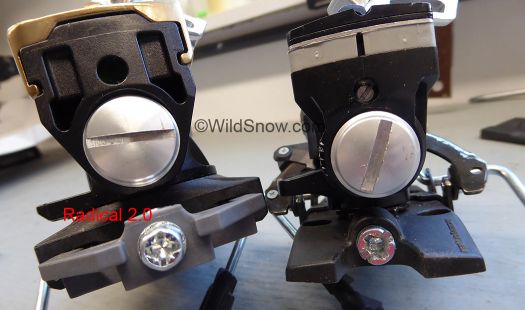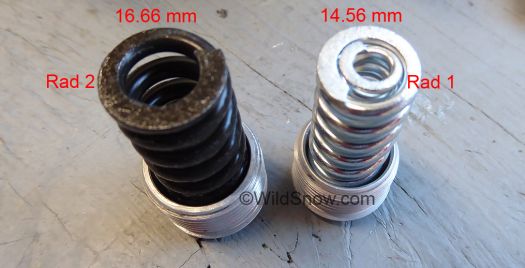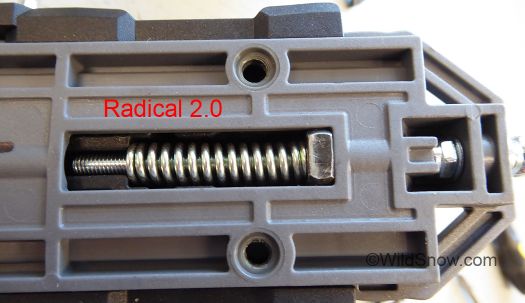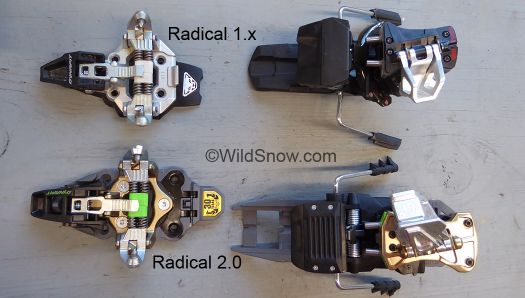
Radical 2.0 at bottom of photo, Radical 1.x at top has been upgraded in numerous ways and is still a viable option that’s lighter and more affordable than Radical 2.0.
First, terminology. Both our vivisection victims are the ST version. Good for comparison, though FT version weights do vary. Further, we’ve lost count of the “in line” variations of the Radical 1 so we tend to call it Radical 1.x not as a joke, simply to make it clear you should pay attention to what version you’re sporting. In truth, I tend to regret not keeping a spreadsheet recording every “in line” change to Radical 1.x, as it would have been fun to number each version and made me look smart. On the other hand, doing so might have been like people who catalog every different shift knob variation used in the 1953 through 1986 Chevrolet Corvette. Smart, or just weird?
Examples of Radical 1 inline changes: Absolute first retail version of Radical 1 had an AFD that failed, which was fixed — yet there are still bindings with the AFD weakness out in the wild, we know so from personal experience and reports. Next came a problem with a clever but dysfunctional “anti rotation” system consisting of a brass pin inside the rear binding housing. This was not user friendly and weakened the housing to the point of easily failing. The legendary pin of brass was fixed with an external anti rotation system. Then a spring was added to help the rear housing move fore/aft as the ski flexed. Next, fragility of the heel unit instigated what we count as at least three different heel unit upgrades. I’ve probably forgotten something, but you get the point.
So, Radical 1.x binding we compare here with 2.0 has all the upgrades, thus weight and such are accurate if not slightly over stated. As always, we have no alternative but to recommend anyone using Radical 1.x sports a binding with all the upgrades. How could we say otherwise in good conscience? In that case, we feel the Radical 1 is equivalent or exceeds functionality and reliability of the Vertical series bindings it replaced (Vertical is our all-time favorite Dynafit full function binding, meaning the option of ski brakes and such).
Onward, first, weights (1.x weights are with all known upgrades, both with <>100 mm brakes, no screws):
Radical 2.0 toe, 224 grams
Radical 2.0 heel, 402 grams
Radical 2.0 total, 626 grams
Radical 1.x toe, 182 grams (with crampon mount at 10 grams)
Radical 1.x heel, 378 grams
Radical 1.x total, 560 grams (66 grams – 2.33 ounces, less than Radical 2.0)
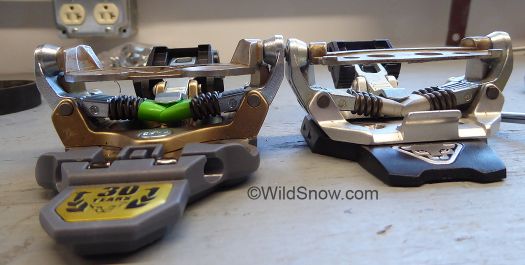
Toe height is virtually the same for both bindings. Radical 2.0 is about 1 mm taller at the toe. Heel height is virtually the same, 50.4 mm to center of heel pins from top of ski. Thus, you get a hair less ramp from Rad 2 — a good trend for most of us. More here about ski touring binding ramp delta angles.
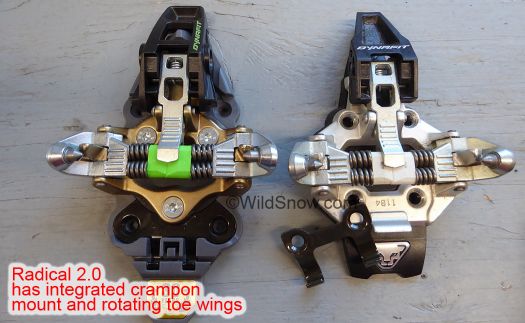
Let’s get the toe unit comparison out of the way first. Well known difference, Radical 2 toe rotates, Radical 1 toe does not. Why ? Most provable reason is that boot toe tech fittings vary. Some boot fittings provide a smooth ball-and-socket action yielding elasticity and return-to-center. Others stick and jam. The rotating toe lets the heel unit provide lateral elasticity no matter how your toe fittings perform (and they’ll release eventually no matter what). Reason #2 is a theory that without rotating toe, the toe “wings” open while the binding heel does its elastic rotation duty, but don’t close completely, and eventually pre-release. Problem is we have zero-zilch-nada lab or field data showing the latter is real. Anecdotal evidence is favorable. But the conversation often goes something like this: “Hey Lou, I ski those things like a god, unlocked, and never prerelease,” then “Sounds good, mister, what DIN have you got them on ?,” “Oh, I just bottom everything out even though I weigh 72 kilo…” Lots that tells us…
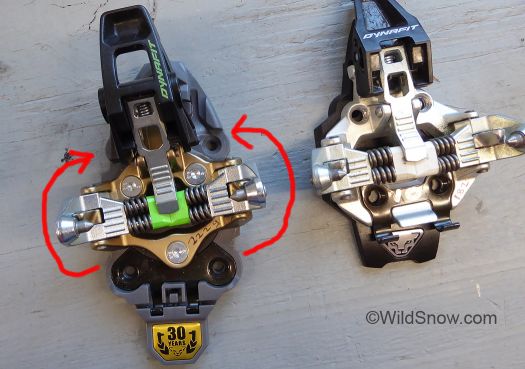
Rad 2 to left, showing rotation. It’s blocked after a certain point but quite flexible. This is a radical concept. To the best of my knowledge there has never in history been a ski binding that had 100% lateral release function at the heel and did not have problems with pre-release when set at “normal” release values. Reason, the basically “moronic” mechanics of ski bindings have a lot of trouble differentiating between heel thrust forces used to turn a ski, as opposed to lateral heel forces that can injure you. Original tech binding design, while not perfect in this regard, did contribute some of its lateral release tension at the toe. Rad 2 does not do so. Difference between Rad 2 and the early problematic bindings is that it’s using the tech binding toe wings as well as Dynafit Power Towers, thus blocking at least one mode of lateral pre release. In the end, this could be genius. We figure another season of consumer testing will give us a better read, but this season did go well both in-house and from what I’m hearing with my ear to the railroad track. Have you been using Radical 2.0 at “normal” release settings? Comments would be appreciated.
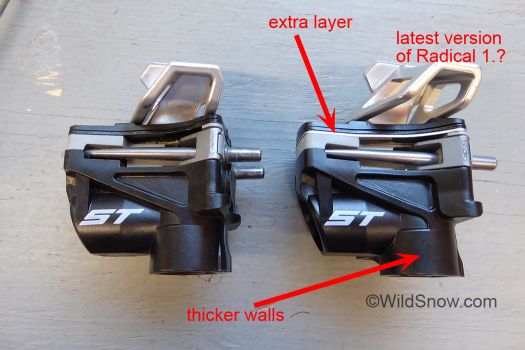
Next, just to get it out of the way, here are a few things you want to look for if you’re buying Radical 1 or have your own and want to be sure about reliability. While there is some question about the need to go to the latest version (with steel plate as indicated) it’s clear that everyone should have basic Radical 1 heel upgrade features detailed in this blog post.
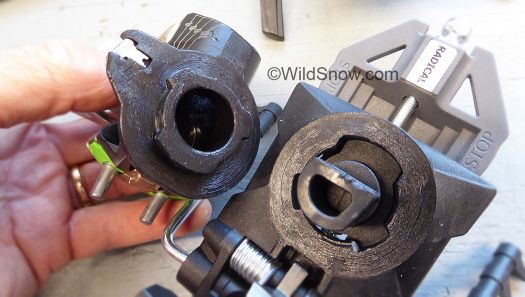
NOW, let us have fun. Removing housing from Radical 2 center spindle is not child’s play. I’m impressed by how Dynafit keyholed the housing down on the spindle so no matter how low you set your release values, it can not pull up off the spindle (rare, but happens with trad tech bindings). Shall we let the exact procedure remain magical? Ask in the comments, or brag how you figured it out.
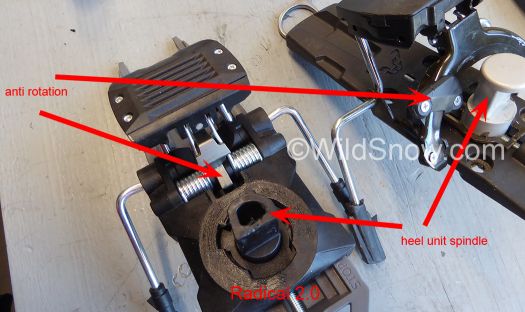
Center spindle of Radical 2 is interestingly made of strong ostensibly carbon infused plastic. I’ve always been a fan of modern plastics, but I have to admit surprise at this departure from aluminum. Thing is, skiers have been breaking tech binding center spindles for years, the alu ones. So why not make a bigger one out of high-tech plastic? Jury definitely out on that! At least plastic is somewhat self lubricating.
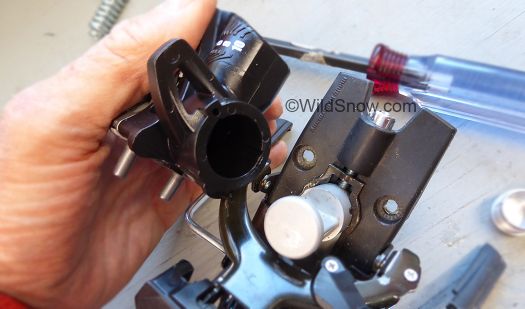
Radical 1 has skinny aluminum spindle the heel unit rides on. Note the vestigial notches inside the bore shown above spindle, those are for the failed “brass pin” anti rotation system of the first Radical, somewhat surprising they’re still there.
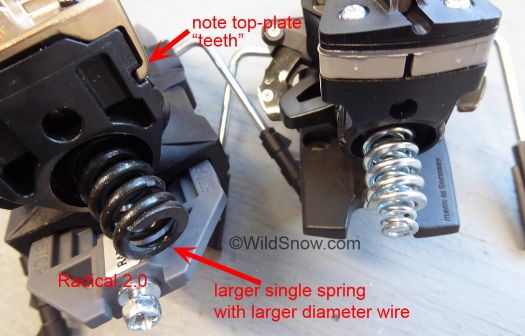
Radical 2 has a large single spring that’s quite powerful. Reason, the rotating toe contributes zero resistance to lateral release so the heel has to be correspondingly stronger. I have no easy way of accurately measuring the difference, but crude experiments indicate that if you set both the Radical 2 and Radical 1 heels to the same lateral release value (e.g., 7), the Radical 2 has around 15% higher tension. Along with that being of rhetorical interest, if you choose to run a 2.0 heel with a 1.* toe you’ll need to dial DOWN your lateral setting accordingly if you want anything close to chart recommended values.
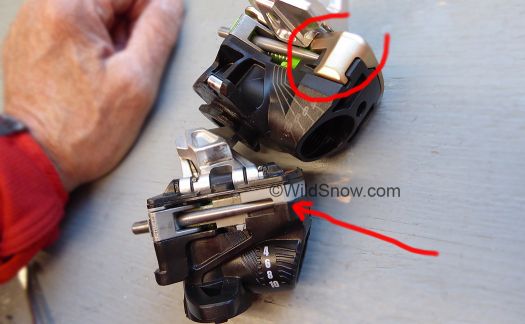
Now we get to durability issues. You never know what will crop up in consumer “testing,” but one thing Radical 2 will not do is break apart like a rejected wedding cake. Re heel unit, the top plate is physically keyed into the lower housing with “teeth” that basic laws of physics say can not fail. Amen Newton!
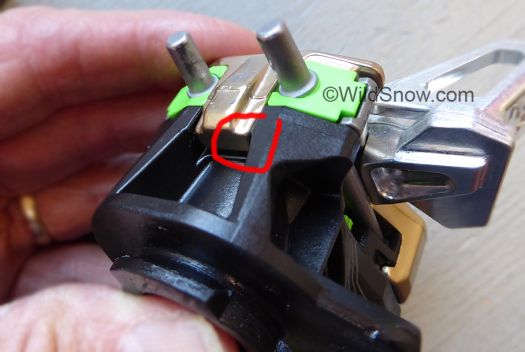
Matter can not occupy the same space as other matter, at the same time. Interesting how long it took engineers to figure that out (I thought they learned that in school), but the solution does appear BOMBER.
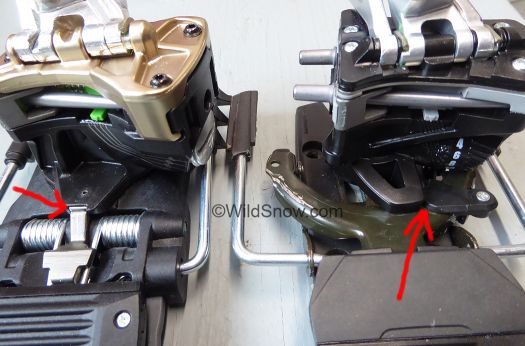
Features that prevent heel unit rotation while in tour mode are important with Radical series bindings. Both bindings integrate brake retraction holder with the anti-rotation. Radical 2.0 to left does it with a clever system of small catches, Radical 1.x to right holds brake by rotating over a metal plate, and the anti rotation stops are attached to the same plate. WE like the 100% positive nature of the 1.x configuration, but the 2.0 system has a nice positive snap when you contract the brake as well as what feels like beefy anti-rotation.
Following photos detail a sometimes perplexing features we’ve seen added to Dynafit’s (and a few other brand’s) bindings over the last few years. Yes, Virginia, a binding needs to compensate for ski flex. Most tech bindings do so by simply allowing heel pins to slide in-out of boot heel fitting. Worked for 25 years, change needed? Read on.
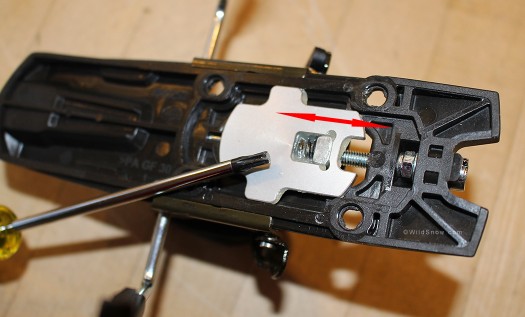
Underside of Radical 1.x showing ski flex compensation spring. A thin stainless steel plate (not shown) sits under the spindle base (shown) on top of the ski allowing the spindle base to slide forward and back about 6 millimeters. Look closely and you can see the spring that enables this function. Because the Radical 1.x is still set to a 5.5 mm heel gap, we are not sure this spring actually does anything for average skiers other than add weight, but it certainly contributes if a ski is strongly flexed and your boot heel gets to the point of banging against the binding heel unit. You can test this to some degree at home by placing a boot in a ski and flexing the ski.
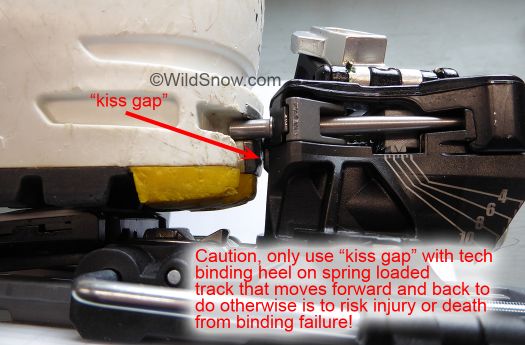
Pictured here is a Dynafit Radical 2.0 heel unit (all black, later versions have green and gold components), with ‘kiss gap’ adjusted to what we think works best, a very small gap that just allows a sliver of light to come through. THIS IS A BIG DIFFERENCE BETWEEN Radical 2 & 1, as all versions of Radical 1.x need a 5.5 mm gap at the heel, including the versions with a flex compensation spring. In my opinion the reason Radical 1 still requires the 5.5 mm gap is the Radical 1 spring system is clearly not as robust as that of the Radical 2.0, which uses the “kiss gap.” More here covering the Dynafit heel gap setting.
Takeaway points about tech binding ski flex compensation springs. 1.)Adjust heel gap correctly. 2.)These are not “forward pressure” springs, they remain passive until activated by the ski flex, and somewhat during lateral release rotation of the heel unit.
There you go folks. I’ll continue dissecting the bindings and adding commentary if more questions come up. Comments on!
Shop for Dynafit Ski Touring Bindings
WildSnow.com publisher emeritus and founder Lou (Louis Dawson) has a 50+ years career in climbing, backcountry skiing and ski mountaineering. He was the first person in history to ski down all 54 Colorado 14,000-foot peaks, has authored numerous books about about backcountry skiing, and has skied from the summit of Denali in Alaska, North America’s highest mountain.

